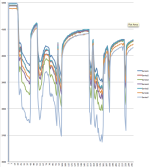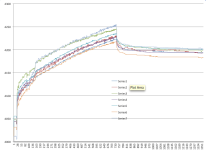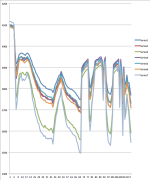DrInnovation
100 W
I am rebuilding some of my lipo packs. each pack had a cell that went bad and dragged the 3P group down below 2.7V (one to 2.3, another to 1.8 another to .85 and a 4th to .67 and 5t and 6th at .35 -- the latter three were from packs sitting on the shelf for quite a while until I thought about disassembling and rebuilding). In every pack but one, it was the bottom group of 3 Cells that had the problem (and the other had a physically broken cell connection). Is it common for the same cell to consistently die?
My bike wants 7S, and until now I've kept things as a custom 1S6P + (3S+3P)2P + (3S3P)2P where + is serial and the (3S3P)2P mean two standard thunderpower 3S3P 11.1v 20C lipo packs connected in parallel cellwise via their balance connectors as well in parallel via their power connector. I did this so I could disassemble them and continue to use my RP charger and test balance using a CellLog8, while still allowing group level parallel.
I've disassembled each group and am recovering the 2 "good" cells, which seem to be holding their charge overnight. I reassembled my first 3P cell group, first one shows an IR of 8mohm testing under a 3A load (.5C). Working my way through the other cells, first restoring to 3.8v letting them sit overnight then taking them 4.2, giving them a day then doing a discharge test and measuring IR.
Working my way through the others and I'm pretty pretty sure I'll have about 12 good cells + 12 normally used cells. I started thinking that maybe the recovered ones will be weaker (though the first IR was good, it was also the least discharged pack), and that maybe I should be rebuild the pack as 3P+3P+4P where the 4P are the recovered cells. This would help make up for any weaker discharge rate and lower capacity in the recovered cells.
(The recoverd 3P3P4P packs would be in parallel via balance leands with undamaged but used 3s3P packs.
I just ordred a BMS from SignalAB, so I figure that can help with the balance with the slightly different group size (especially if the 4P is from cells that really do have lower capacity). Am i missing something that might cause problems with this configuration?
Also if I'm going to rebuild and use a BMS, should I just scrap the idea of keeping the pack in normal configuration (I'll be down to two anyhow and not sure I'd want to fly with them given the year of use on the bike) or just rebuild all the good cells I have left into a single 7s where I spread the recovered cells out and put together as many 7P and leave the rest as 6P. This would put all the cells I have to use and might be simpler for the balance leads connection to BMS. With a BMS Is having some extra weak cells (but not shorted and reasonable IR) connected in parallel with the group a good idea, or should I just keep it with the best 42 cells I can get in the 7s6P configuration?
My bike wants 7S, and until now I've kept things as a custom 1S6P + (3S+3P)2P + (3S3P)2P where + is serial and the (3S3P)2P mean two standard thunderpower 3S3P 11.1v 20C lipo packs connected in parallel cellwise via their balance connectors as well in parallel via their power connector. I did this so I could disassemble them and continue to use my RP charger and test balance using a CellLog8, while still allowing group level parallel.
I've disassembled each group and am recovering the 2 "good" cells, which seem to be holding their charge overnight. I reassembled my first 3P cell group, first one shows an IR of 8mohm testing under a 3A load (.5C). Working my way through the other cells, first restoring to 3.8v letting them sit overnight then taking them 4.2, giving them a day then doing a discharge test and measuring IR.
Working my way through the others and I'm pretty pretty sure I'll have about 12 good cells + 12 normally used cells. I started thinking that maybe the recovered ones will be weaker (though the first IR was good, it was also the least discharged pack), and that maybe I should be rebuild the pack as 3P+3P+4P where the 4P are the recovered cells. This would help make up for any weaker discharge rate and lower capacity in the recovered cells.
(The recoverd 3P3P4P packs would be in parallel via balance leands with undamaged but used 3s3P packs.
I just ordred a BMS from SignalAB, so I figure that can help with the balance with the slightly different group size (especially if the 4P is from cells that really do have lower capacity). Am i missing something that might cause problems with this configuration?
Also if I'm going to rebuild and use a BMS, should I just scrap the idea of keeping the pack in normal configuration (I'll be down to two anyhow and not sure I'd want to fly with them given the year of use on the bike) or just rebuild all the good cells I have left into a single 7s where I spread the recovered cells out and put together as many 7P and leave the rest as 6P. This would put all the cells I have to use and might be simpler for the balance leads connection to BMS. With a BMS Is having some extra weak cells (but not shorted and reasonable IR) connected in parallel with the group a good idea, or should I just keep it with the best 42 cells I can get in the 7s6P configuration?




